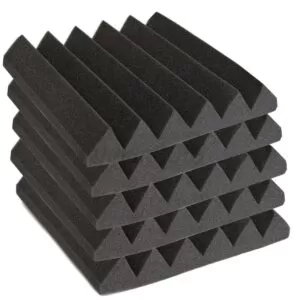 The most cost effective method for controlling unwanted sound wave reflections in a room is to apply thick sound foam panels around the room’s perimeter. As the sound waves enter the foam, the pores accept the energy and begin to vibrate. This conducts low grade heat, which means the sound energy is converting to kinetic energy, re moving the reflection echoes from the room. Foams come in many shapes and sizes, in both class B and class A rated fire codes. Sound Foam Panels for public venues, such as hospitals, schools and churches, should be cut from melamine foam, which is class A fire approved. Industrial, recording, studio and residential treatments will typically target class B rated foams, made from open cell polyurethane foam.
The most cost effective method for controlling unwanted sound wave reflections in a room is to apply thick sound foam panels around the room’s perimeter. As the sound waves enter the foam, the pores accept the energy and begin to vibrate. This conducts low grade heat, which means the sound energy is converting to kinetic energy, re moving the reflection echoes from the room. Foams come in many shapes and sizes, in both class B and class A rated fire codes. Sound Foam Panels for public venues, such as hospitals, schools and churches, should be cut from melamine foam, which is class A fire approved. Industrial, recording, studio and residential treatments will typically target class B rated foams, made from open cell polyurethane foam.
Acoustic foam, commonly referred to as sound-absorbing foam or soundproof foam, is available in many different colors, surface patterns, thickness and NRC (noise reduction coefficient) ratings. They can be in the form of wall panels, ceiling panels and ceiling clouds, ceiling tiles for glue on applications, or fitting in a T-grid.
Melamine foam meets all Class A fire ratings, and can be used in applications such as in factories, recording and broadcast studios, auditoriums, churches, classrooms and many other facilities to correct a sound or noise problem.
Note that the thicker panels will perform better with low base frequencies like drums, machinery, barking dogs, etc…while thinner panels work just fine for human voice.


